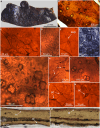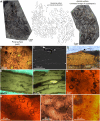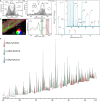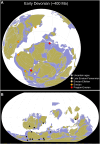The rise of lichens during the colonization of terrestrial environments
- PMID: 41160691
- PMCID: PMC12571074
- DOI: 10.1126/sciadv.adw7879
The rise of lichens during the colonization of terrestrial environments
Abstract
The origin of terrestrial life and ecosystems fundamentally changed the biosphere. Lichens, symbiotic fungi-algae partnerships, are crucial to nutrient cycling and carbon fixation today, yet their evolutionary history during the evolution of terrestrial ecosystems remains unclear due to a scarce fossil record. We demonstrate that the enigmatic Devonian fossil Spongiophyton from Brazil captures one of the earliest and most widespread records of lichens. The presence of internal hyphae networks, algal cells, possible reproductive structures, calcium oxalate pseudomorphs, abundant nitrogenous compounds, and fossil lipid composition confirms that it was among the first widespread representatives of lichenized fungi in Earth's history. Spongiophyton abundance and wide paleogeographic distribution in Devonian successions reveal an ecologically prominent presence of lichens during the late stages of terrestrial colonization, just before the evolution of complex forest ecosystems.
Conflict of interest statement
The authors declare that they have no competing interests.
Figures







References
-
- Strother P. K., Servais T., Vecoli M., The effects of terrestrialization on marine ecosystems: The fall of CO2. Geol. Soc. Lond. Spec. Publ. 339, 37–48 (2010).
-
- Edwards D., Cherns L., Raven J. A., Could land-based early photosynthesizing ecosystems have bioengineered the planet in mid-Palaeozoic times? Palaeontology 58, 803–837 (2015).
-
- Rubinstein C. V., Gerrienne P., de la Puente G. S., Astini R. A., Steemans P., Early Middle Ordovician evidence for land plants in Argentina (eastern Gondwana). New Phytol. 188, 365–369 (2010). - PubMed
-
- Spaak G., Edwards D. S., Foster C. B., Pagès A., Summons R. E., Sherwood N., Grice K., Environmental conditions and microbial community structure during the Great Ordovician Biodiversification Event; a multi-disciplinary study from the Canning Basin, Western Australia. Glob. Planet. Change 159, 93–112 (2017).
-
- Libertín M., Kvaček J., Bek J., Žárský V., Štorch P., Sporophytes of polysporangiate land plants from the early Silurian period may have been photosynthetically autonomous. Nat Plants 4, 269–271 (2018). - PubMed
MeSH terms
LinkOut - more resources
Full Text Sources

